

Diana Barrett
What is copyright? Copyright Alliance - Resources and FAQs. A copyright is a collection of rights that automatically vest to someone who creates an original work of authorship – like a literary work, song, movie or software. These rights include the right to reproduce the work, to prepare derivative works, to distribute copies, and to perform and display the work publicly. To understand how these rights can be used or licensed, it’s helpful to analogize them to a bundle of sticks, where each stick represents a one of these rights. The copyright owner has the right to keep each “stick” for themselves, to transfer them individually to one or more people, or to transfer them collectively to one or more people.
In short, copyright allows the owner to choose the ways his/her copyrighted works are made available to the public. The basis for copyright protection stems directly from the U.S. Copyright. What is copyright?
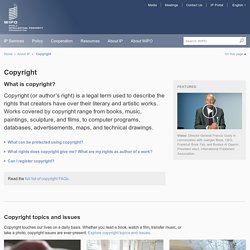
Copyright (or author’s right) is a legal term used to describe the rights that creators have over their literary and artistic works. Works covered by copyright range from books, music, paintings, sculpture, and films, to computer programs, databases, advertisements, maps, and technical drawings. Students and Copyright. | Next Page What is copyright?
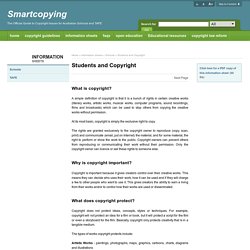
A simple definition of copyright is that it is a bunch of rights in certain creative works (literary works, artistic works, musical works, computer programs, sound recordings, films and broadcasts) which can be used to stop others from copying the creative works without permission. At its most basic, copyright is simply the exclusive right to copy. Using Items from the Library’s Website: Understanding Copyright Here’s the most important thing to know: If you can see or hear the materials on the Library of Congress website, you may view or listen to them on the site.
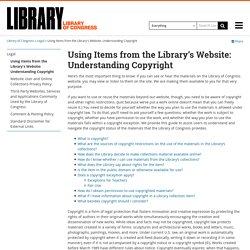
We are making them available to you for that very purpose. If you want to use or reuse the materials beyond our website, though, you need to be aware of copyright and other rights restrictions. (Just because we’ve put a work online doesn’t mean that you can freely reuse it.) You need to decide for yourself whether the way you plan to use the materials is allowed under copyright law. To do that, you’ll need to ask yourself a few questions: whether the work is subject to copyright, whether you have permission to use the work, and whether the way you plan to use the materials falls within a copyright exception. Copyright is a form of legal protection that fosters innovation and creative expression by protecting the rights of authors in their original works while simultaneously encouraging the creation and dissemination of new works. Teaching Copyright (Videos) Copyright. 5-Minute Film Festival: Copyright and Fair Use for Educators.
I absolutely love it when teachers and students create, remix, and mash up media; it's a fantastic way to encourage deeper learning and media literacy.

But one issue that complicates digital freedom of expression is copyright law. While many would argue that copyright law is outdated and badly in need of an overhaul, it's still critical that adults and kids alike have a basic understanding of what's legal and ethical while playing with other people's intellectual property. Here's a list of videos I collected to help you navigate the murky waters of copyright law in educational settings.
Video Playlist: Understanding Copyright and Fair Use Watch the first video below, or watch the whole playlist on YouTube. Copyright & Creativity for Ethical Digital Citizens – A New Literacy. Copyright, What's Copyright? Copyright Basics. Copyright for Educators. The Educator's Guide to Creativity & Copyright. Home. Copyright: Classroom F2F and Distant Learning. The Educator's Guide to Copyright and Fair Use. A five-part series When it comes to copyright law and the application of fair use exceptions, ignorance is definitely not bliss! Learn how to educate yourselves and your students and avoid making a costly mistake! You really did plan to find time over the summer to familiarize yourself with the latest information on copyright law.
You absolutely intended to look up the fair use guidelines for using technology resources. Copyright Laws for Teachers: Educational CyberPlayGround® CITE - the Educational CyberPlayGround, Inc.
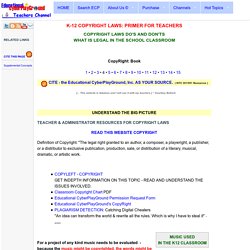
AS YOUR SOURCE. ( ISTC 301/501 Resources ) [... Use of Copyrighted Material in the Classroom - Faculty: Counseling - LibGuides at Marymount University. Fair use explicitly allows use of copyrighted materials for educational purposes such as criticism, comment, news reporting, teaching, scholarship, and research.

Rather than listing exact limits of fair use, copyright law provides four standards for determination of the fair use exemption: Purpose of use: Copying and using selected parts of copyrighted works for specific educational purposes qualifies as fair use, especially if the copies are made spontaneously, are used temporarily, and are not part of an anthology.Nature of the work: For copying paragraphs from a copyrighted source, fair use easily applies. The Campus Guide to Copyright Compliance. Distance Learning and Copyright: Is a Solution in Sight? This article was published in CAUSE/EFFECT journal, Volume 22 Number 3 1999.

The copyright is shared by EDUCAUSE and the author. See for additional copyright information. Distance Learning and Copyright: Is a Solution in Sight? By Laura N. GasawayFor at least the past decade, educators have looked toward distance education as a way to create educational opportunities for underserved populations. Copyright and Distance Learning Information: Tips & Resources for Educators : Copyright & Creativity. Print or download PDF Tips and Resources for Teachers and Administrators March 31, 2020 As teachers and students shift their educational and social activity online due to the COVID-19 crisis, they are more likely than ever to find themselves using and interacting with media in ways that raise copyright questions.
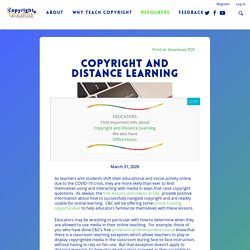
As always, the free lessons and videos at C&C provide positive information about how to successfully navigate copyright and are readily usable for online learning. C&C will be offering some online training opportunities to help educators familiarize themselves with these lessons. Copyright for Students. The Right Stuff: Teaching Kids About Copyright. Help kids learn how to find and use other people's creative works legally and ethically.
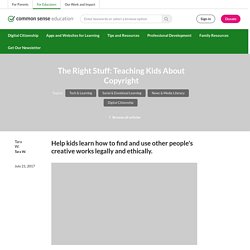
We (rightfully) spend significant time and energy teaching kids to be aware of their digital footprints. Stories abound about momentary lapses of judgment leading to loss of employment or scholarships. Students tend to embrace these lessons because they care about reputation. Obviously, we must continue these important lessons; however, we must realize that digital citizenship encompasses other online behavior, too. Welcome To The FACE Kids Site.
Copyright Facts for Kids. A copyright is a law that gives the owner of a written document, musical composition, book, picture, or other creative work, the right to decide what other people can do with it.

Copyright laws make it easier for authors to make money by selling their works. Because of copyright, a work can only be copied if the owner of the copyright gives permission. When someone copies or edits a work that is protected under copyright without permission, the owner may sue for the value of the violation. Most such cases are handled by civil law. In more serious cases, a person who copies a work that is protected under copyright could be arrested, fined or even go to prison. Students as Creators: Exploring Copyright. Home › Classroom Resources › Lesson Plans Lesson Plan Overview Featured Resources From Theory to Practice This lesson gives students the tools they need to consider the ethical issues surrounding use and ownership of copyrighted materials.
This lesson plan was developed as part of a collaborative professional project with the American Library Association Office for Information Technology Policy and the American Association of School Librarians (AASL). Copyright and Fair Use Information for Images, Music, Performances, and Videos. Can You Show Netflix in Class? Copyright for Teachers Made Simple. Can I show a video from Netflix in my classroom? Can I make 25 copies from my favorite math workbook? I just need three more copies of our book, can I make those? As educators, we use a variety of resources in our classroom to enhance a lesson.
Media in theClassroom - Copyright & Fair Use - Subject and Course Guides at University of Texas at Arlington. Section 110(1) of the Copyright Act addresses performance and display of copyrighted materials in the face-to-face classroom. The TEACH Act addresses performance and display in online teaching (teaching through digital transmission as in Blackboard). FAQs about Classroom Uses of Video (Performance) 1. Copyright Law: What Music Teachers Need to Know. By Ken Schlager Intellectual property has emerged from the legal backwater to become major news, with frequent high-profile cases of individuals and companies being prosecuted for the illegal use and distribution of copyrighted material. While teachers enjoy many exemptions under copyright law, the classroom does not shelter all uses.
As teachers choose materials for their students, it is essential that they know where the legal lines are drawn. The principle of copyright protection in the United States can be traced back to the Constitution. Over the years, Congress has codified these protections in succeeding versions of the Copyright Act. Copyright: Performance Exemptions. Bitmoji brand guidelines. Creative Commons. What Is Creative Commons and Why Does It Matter? As K-12 educators, you face unique challenges when it comes to using the Web. Not only are you trying to find resources to aid your teaching, but you're also on the lookout for resources that your students can use -- legally, technically, and socially. Types of Creative Commons license. Creative Commons is a non-profit organisation that offers an alternative to full copyright.
By placing a Creative Commons statement on your blog, you are specifying the terms of use for anyone who would wish to use your material. Flickr: Creative Commons. Many Flickr users have chosen to offer their work under a Creative Commons license, and you can browse or search through content under each type of license.
Here are some recently added bits and pieces: Attribution License » 89205806 photos (See more) Attribution-NoDerivs License. Public Domain: Duration - CopyrightUser. 9 Great Websites for Free Images to Use in Class and School Projects. What can not be copyrighted? No One Can Copyright These 15 Things, and They May Surprise You. 5 Things That Can't Be Copyrighted. Modern copyright law can feel extremely broad at times. Every creative work made, whether it is a doodle on a napkin, a photograph or a poem, once it is fixed into a tangible medium of expression, the creator holds the copyright to it. No notice nor any further action is required (though registration with the U.S. Copyright Office has many added benefits). Still, there are many things that can not be copyrighted. They either don’t fall under the jurisdiction of copyright or don’t qualify for its protection.
Works Not Covered By Copyright. You may want to use or incorporate someone else's work into your own.